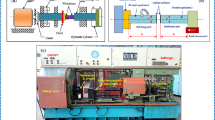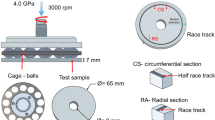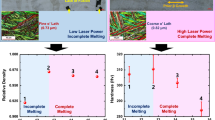Abstract
Investigation of fracture toughness on Ti-6.5Al-2Zr-1Mo-1V alloy thin sheet and its laser-welded joints has been carried out. In the test compact tension (CT) specimens and single specimen technology were used. In addition, hardness distribution and microstructure of the welded joints were examined. Fracture test indicates that brittle unstable fracture occurs after slow crack propagation for all the specimens, except that one heat affected zone (HAZ) specimen is brittle crack initiation. It is found that rolling directions have no obvious effect on fracture toughness of base metal. Moreover, fracture toughness of weld metal is obviously decreased in comparison with base metal whatever in as-welded condition or in stress relief condition. Post-weld heat treatment (PWHT) leads to fracture toughness of the welds further decreasing. Fractography observation shows that the fracture mode is predominantly dimpled in base metal. However, there exists intergranular fracture in the weld metal. Thus, the transition of fracture mode from both base metal and HAZ to weld metal may lead to dramatic decrease in fracture toughness. Microstructure examination reveals that the microstructure of weld metal consists of large grains with fine acicular structure. The formation of fine α acicular structure is due to rapid cooling during laser welding. After PWHT, the acicular structure is coarsened.







Similar content being viewed by others
References
Khorev MA (1983) Automat Wel 7:21 (in Russian)
Yao W, Gong SL, Chen L (2003) Welding 7:21 (in Chinese)
Gong SL, Tang Y, Du X, Ba RZ (2002) Welding 10:32 (in Chinese)
Wang ZM, Hong XF, Cao WJ (2005) Aerosp Manufact Technol 1:4 (in Chinese)
Xiong LT, Zhou ZG, Dong ZG (2006) Trans China Weld Inst 27:49 (in Chinese)
Du X, Liu LM, Song G, Wang M, Yang L (2005) Trans China Weld Inst 26:45 (in Chinese)
Keshava MK, Sundaresan S (1997) Weld J 76:81s
Thomas G, Ramachandra V, Ganeshan R, Vasudevan R (1993) J Mater Sci 28:4892, DOI: 10.1007/BF00356539
Barreda JL, Santamaria F, Azpiroz X, Irisarri AM, Varona JM (2001) Vacuum 62:143
Zhou W, Chew KG (2003) Mater Sci Eng A347:180
Kweietniewski C, Santos JF, Silva AM, Pereira L, Strohaecker TR, Reguly A (2006) Mater Sci Eng A417:49
Torsten F, Santos JF, Kocak M, Penasa M (1998) In: ASM Proceedings of the International conference: Trends in Welding Research, Pine Mountain, GA, ASM International and American Welding Society, 887
National Standards (2001) GB 3076-82 Standard test method for tensile testing of metallic thin sheet, China Standards Publisher, Beijing
British Standard (1997) BS 7448, Method for determination of K 1c, critical CTOD and critical J value of welds in metallic materials, London
Acknowledgement
The authors would like to express their thanks to the financial support from the State Defence Key Laboratory For High Energy Density Beam Processing Technology.
Author information
Authors and Affiliations
Corresponding author
Rights and permissions
About this article
Cite this article
Shi, Y., Zhong, F., Li, X. et al. Effect of laser beam welding on fracture toughness of a Ti-6.5Al-2Zr-1Mo-1V alloy sheet. J Mater Sci 42, 6651–6657 (2007). https://doi.org/10.1007/s10853-007-1524-y
Received:
Accepted:
Published:
Issue Date:
DOI: https://doi.org/10.1007/s10853-007-1524-y




